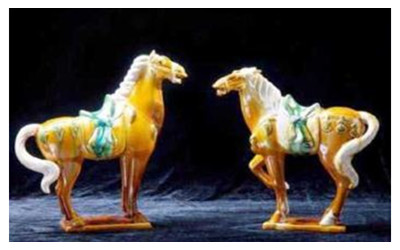Skype: neodalle-travel
Tel: +86 135 7447 2266
E-mail: sales@zhangjiajieholiday.com
 Tang Sancai
Tang Sancai
Tang Sancai, the trio-colored glazed pottery of the Tang Dynasty, has three basic colors, yellow, brown and green, thus being called Sancai, which means “three colors” in Chinese. Colorful as it is, the three basic colors of red, green and white are distinct. So Sancai refer to the natural color of the pottery. As the development of archeology, many Tang Saicai of other colors appeared, the three basic colors being far exceeded. Some believe that “San”, namely “three” in Chinese, refer to a general idea of “many”, especially in ancient Chinese, frequently, without stress on a specific number. Therefore the “San” of “Tang Sancai” means “many” instead of “three”.
Nanyang Jade Carving
The Dushan Mountain, eight kilometers to the north of the Nanyang City, is abundant with fine jades. Besides topping the other three kinds of famous jades in China in output, Dushan jade has a wide range of colors covering more than 30 categories including red, orange, yellow, green, green-blue, blue, purple and others. With hardness, transparency, high quality and shine, Dushan jade is perfect for carving. Products of over 120 categories fall into four major groups, which are people, flowers and birds, animals, pavilions and buildings, to be specific.
Ruyang Plum Blossom Jade
Meihuayu (the Plum Blossom Jade) gets its name for the colorful patterns like plum blossoms. It is also named Ruyu (the Jade of Ruyang) since it was found in the Shangdian Town of Ruyang County, Henan Province, where the Yangshao Cultural Heritages lie.
As recorded, Liu Xiu, the Guangwu Emperor of the Han Dynasty, bestowed the jade with the name of “National Treasure”. With a fine texture, the Meihuayu looks like shining crystal with dark shade of vivid plum blossoms embedded in. The body-building balls, bracelets, tea-sets, wine-sets, stationeries and other handicrafts made by Meihuayu are glorious, stately and delicate, thus bringing Meihuayu the laurel of “Jade of the East”.
Nanyang Pyrograph
Taking the wood of euonymus microcarpus as raw material, pyrograph is the traditional handicraft of Nanyang, Henan Province. Nanyang Pyrograph originated during the Emperor Guangxu Period of late Qing Dynasty involving pyrogragh of chopsticks, rulers, duster handles, later the large landscape pictures, human images, desk lamps, portraits and so on. More raw materials such as the euonymus microcarpus, the veneers and the rice paper were put into use together as needed. With themes mainly on classic novels, fairy tales and the landscapes, Nanyang Pyrographs are clear, white and exquisite in wood, never fading. Nanyang Pyrographs have been exported to more than 60 countries all over the world, besides being popular in domestic market.
Zhuxianzhen Nianhua
Zhuxianzhen Nianhua, the New Year pictures of Zhuanxian Town, originated in the Tang Dynasty and flourished in Ming Dynasty and Qing Dynasty. It is said that the town of Zhuxianzhen in Kaifeng is the cradle of Chinese xylograph. The lines being bold and exaggerated in a romantic way, the structure integrated, Zhuxianzhen Nianhua is rich in the taste of Chinese village, unstrained with primitive simplicity and prominent local features. With themes on well-known people, stories and legends, Nianhua, the New Year pictures, are very popular among the Chinese, with a wide range of categories involving pictures of gods hung on doors, in kitchens, in guest rooms and so on.
 Ask Questions ?
Ask Questions ?